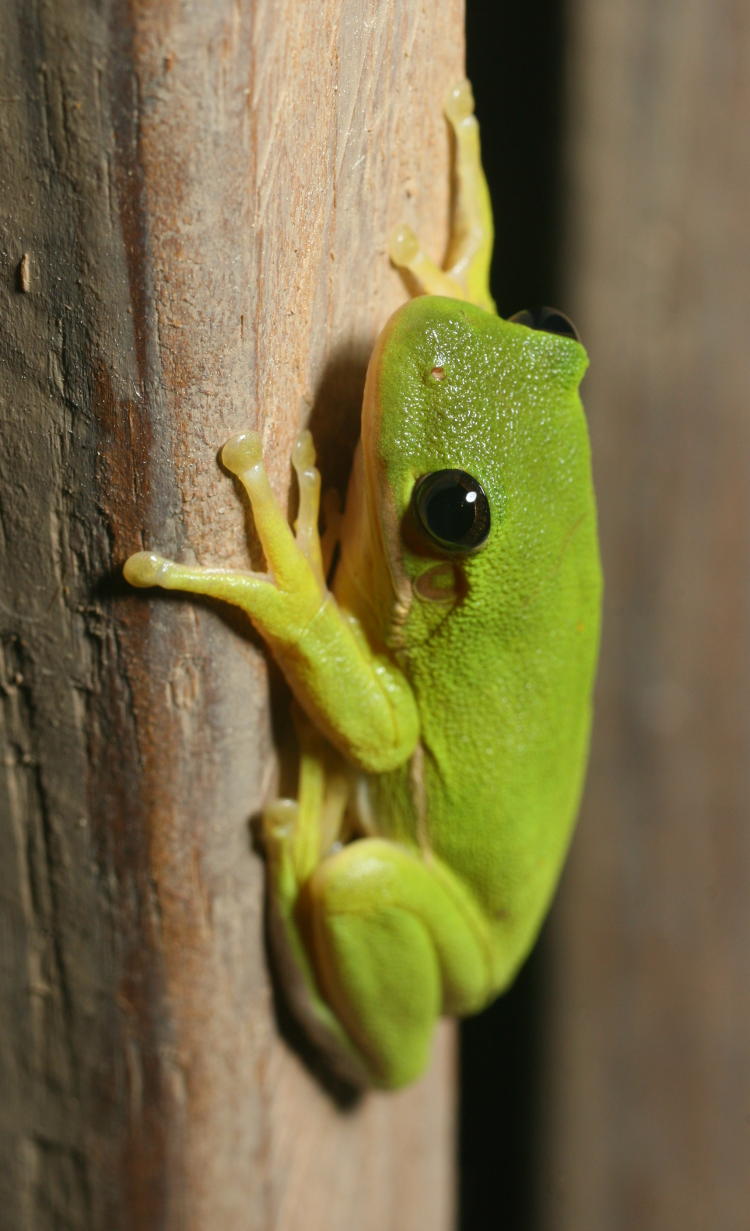I’m trying to get back into shooting a little more regularly, not at all helped by not seeing much to shoot, not having a lot of free time that isn’t taken up with projects, and now not having the best weather. And yet, despite those overwhelming difficulties, I can still come through in the clutch!
[Ahem] Anyway, I snagged just a handful of frames this past evening, most of which I shot while on the phone, because multitasking! This first, however, was earlier in the afternoon between rain showers, as The Girlfriend’s new hibiscus plant began blooming earlier this week. The petals were starting to show wear and weren’t as healthy looking now, so I went selective.

While I had the camera in hand chasing other subjects, I happened across this lesser meadow katydid nymph (genus Conocephalus) and did a quick couple of frames before it leapt away.

A few days earlier, I had seen this next one twice, surprising me a little because the green treefrogs (Hyla cinerea) have been absent from the yard since spring, but now at least one has reappeared. I kinda wish I’d had the time to shoot it when I first saw it back then, because it was perched on a much more photogenic setting than our porch railings, but so it goes.

There’s a detail in this image that we’re going to see much closer in a later post. Just to, you know, get you all anticipating and stuff.
I was pleasantly surprised to find this juvenile Copes grey treefrog (Hyla chrysoscelis,) obviously one of the many broods hatched from the backyard pond. They’ve mostly been scarce recently, though whether this is from moving on, spending more time in the upper reaches of the trees, or falling prey to predators, I can’t say. This one isn’t significantly bigger than the last couple of times that I’ve photographed one, maybe about the size of your thumbnail.

I’m not sure why the grey treefrogs haven’t been cooperating by posing on something appropriate and interesting; they seem to really like plastic somehow, because I’ve been seeing them on rainbarrels and now a recycling bin, hardly the kind of natural setting that’s going to make a better shot. But I still like how well the skin quality came up with this one, equal parts translucent and almost-iridescent. They gain a lot from going in close. I mean, seriously, those toes just look like jelly, making it easy to forget there are teeny little bones in there.
 And this last one I’m only going to show at minimal size, because focus was slightly off and this is obvious when viewed any larger, but it proves that we have a resident (for the time being anyway) southern flying squirrel (Glaucomys volans) – in fact, we have two, because there’s one occupying another bluebird box in the backyard as well. They have two nesting seasons a year, spring and fall, and so we’re expecting two broods, but whether I can manage any better photos will wait to be seen – I’m very wary of scaring them off. In fact, I’m going out later on today to pick up some mealworms and nut mixes to place in visible locations near the nest boxes, to help convince them this is a cool location and assist in the feeding demands of the young.
And this last one I’m only going to show at minimal size, because focus was slightly off and this is obvious when viewed any larger, but it proves that we have a resident (for the time being anyway) southern flying squirrel (Glaucomys volans) – in fact, we have two, because there’s one occupying another bluebird box in the backyard as well. They have two nesting seasons a year, spring and fall, and so we’re expecting two broods, but whether I can manage any better photos will wait to be seen – I’m very wary of scaring them off. In fact, I’m going out later on today to pick up some mealworms and nut mixes to place in visible locations near the nest boxes, to help convince them this is a cool location and assist in the feeding demands of the young.
If I make any noise at all in the front yard, I will often see this one peer out to check on me, and have routinely noted the bedding inside, visible in the opening when her head’s not in the way, in different positions, so if there isn’t presently a brood within, there soon will be. Now I’m leery of mowing the lawn, but I suppose she’s settled in enough to cope, and the food offering might help ease her concerns. This shot was obtained by manually focusing with the headlamp while using the Canon 100-300 L and the powerful Metz 40 MZ-3i, which hasn’t been getting a lot of use recently since the macro workhorse (the Sunpak Auto 322) has been what was called for – and used for all other shots in this post. Given the distance that I want to work from to avoid spooking the squirrel, the Metz is likely to see a bit more activity. Again, we’ll just have to see what transpires.



















































